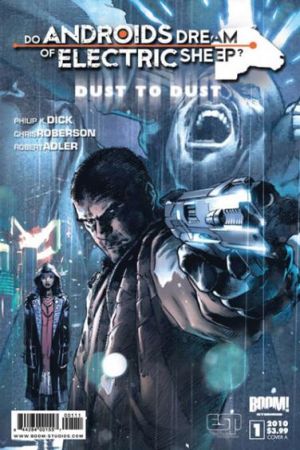- Comics
- Comics Reviews
- Manga
- Comics Reviews
- European Comics
- News
- Comics News
- Press Releases
- Columns
- Spotlight
- Digital Comics
- Webcomics
- Cult Favorite
- Back Issues
- Webcomics
- Movies
- Toys
- Store
- More
- About
By Dan Horn
May 28, 2010 - 21:24
 |
Even more recently, the comic book publisher BOOM! Studios acquired the rights to Philip's DADOES?, turning it into one of the most lauded comic book series of last year and earning the twenty-four-issue mini-series an Eisner-nomination. Now Dick's Electric Ant has hit comic store shelves as well, and BOOM! has just released an authorized prequel to the fan-beloved DADOES? canon.
Whereas BOOM! Studios' Do Androids... was entirely loyal to Philip's source material, serving as a direct transplant from prose to graphic rendering (illustrated by Tony Parker and Bill Sienkiewicz), the new series DADOES?: Dust to Dust seeks to add even more depth (if that's at all possible) to its classic predecessor's continuity. How does it fare?
Surprisingly well, actually. Chris Roberson does a fine job of staying true to PKD's bleak yet at times caustically comedic vision of America's post-nuclear war future. Roberson gives us a thoughtful retreading of philosophical motifs which beg the question, what is life and why is it so sacred? This sentiment is echoed by the main character, Charlie Victor, an android hunting other renegade androids, in the opening panels.
"So strange. Once life has fled, what's left behind is just this... thing. Like a machine that's run out of fuel."
Charlie Victor is after Talus and his gang of runaway C-V androids. Talus is wise to Victor's presence in the toxic California city, but Charlie Victor's got an ace up his sleeve: Malcolm Reed. Reed is a clairvoyant, heavily medicated to block out the auras of those around him, but without his medications, Reed is able to distinguish the almost invisible line separating android and man. Malcolm's inner, third-person monologue is some of the most spot-on character developing implemented in comic books today. Roberson leisurely makes Malcolm's strange character seem somehow extremely accessible.
Robert Adler's panel work gives scenes the seamless transitions they need to carry a story divided amongst several main characters. His use of shadows and intense urban backdrops make Dust to Dust just as gritty as this prequel should be.
Rating: 9 /10